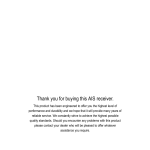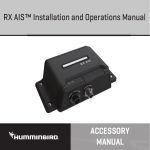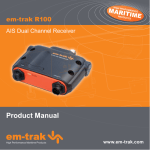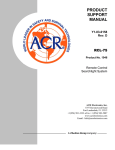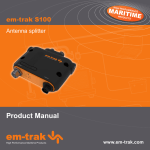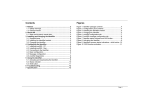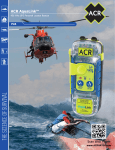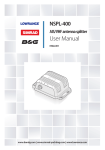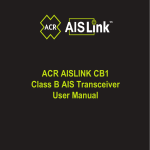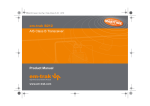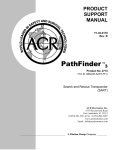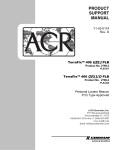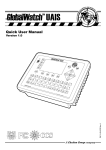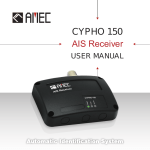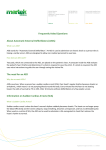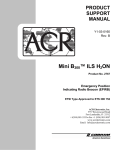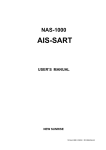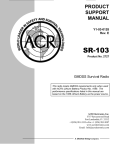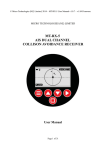Download ACR Krypton Manual V2.0.book
Transcript
Thank you for buying this AIS receiver. This product has been engineered to offer you the highest level of performance and durability and we hope that it will provide many years of reliable service. We constantly strive to achieve the highest possible quality standards, should you encounter any problems with this product, please contact your dealer who will be pleased to offer whatever assistance you require. Table of contents Table of figures 1 Notices ..................................................................................................1 Figure 1 1.1 Safety warnings ......................................................................................1 Figure 2 Items included in the product..................................................... 3 AIS receiver overview................................................................ 4 1.2 General notices ......................................................................................1 Figure 3 Electrical connections to the AIS receiver ................................. 4 2 Typical installation configuration................................................ 5 About your AIS receiver ......................................................................2 Figure 4 2.1 About AIS ...............................................................................................2 Figure 5 AIS receiver dimensions............................................................ 7 2.2 Static and dynamic vessel data..............................................................2 Figure 6 AIS receiver mounting ............................................................... 8 2.3 What's in the box? ..................................................................................3 Figure 7 Position of the VHF antenna connector..................................... 8 3 Installation ............................................................................................5 Figure 8 Connecting to the NMEA0183 data port.................................... 9 3.1 Preparing for installation.........................................................................5 Figure 9 Connecting the power supply .................................................. 10 3.2 Installation procedures ...........................................................................6 Figure 10 Indicator location on the AIS receiver unit ............................... 11 4 Operation ............................................................................................11 4.1 Using the AIS receiver..........................................................................11 4.2 Indicator functions ................................................................................11 5 Troubleshooting .................................................................................12 6 Specifications .....................................................................................13 7 Warranty..............................................................................................14 Notices 1 Notices ! When reading this manual please pay attention to warnings marked with the warning triangle shown on the left. These are important messages for safety, installation and usage of the product. Failure to do so can result in personal injury and / or AIS receiver malfunction. Caution: The antenna should not be co-located or operated in conjunction with any other transmitting antenna. The required antenna impedance is 50Ω. Warranty 1.1 Safety warnings ! ! ! This equipment must be installed in accordance with the instructions provided in this manual. This equipment is intended as an aid to navigation and is not a replacement for proper navigational judgement. Do not install this equipment in a flammable atmosphere such as in an engine room or near to fuel tanks. 1.2 General notices Compass safe distance The compass safe distance of this unit is 0.5m or greater for 0.3° deviation. RF emissions notice Caution: The AIS receiver generates and radiates radio frequency electromagnetic energy. This equipment must be installed and operated according to the instructions contained in this manual. Page 1 This product is supplied with standard warranty as defined in section 7. ! Any attempt to tamper with or damage this product will invalidate the warranty. Disposal of this product and packaging Please dispose of the AIS receiver in accordance with the European WEEE Directive or with the applicable local regulations for disposal of electrical equipment. Every effort has been made to ensure the packaging for this product is recyclable. Please dispose of the packaging in an environmentally friendly manner. Accuracy of this manual The AIS receiver may be upgraded from time to time and future versions of the AIS receiver may therefore not correspond exactly with this manual. The manufacturer of this product disclaims any liability for consequences arising from omissions or inaccuracies in this manual and any other documentation provided with this product. About your AIS receiver 2 About your AIS receiver 2.1 About AIS The marine Automatic Identification System (AIS) is a location and vessel information reporting system. It allows vessels equipped with AIS to automatically and dynamically share and regularly update their position, speed, course and other information such as vessel identity with similarly equipped vessels. Position is derived from the Global Positioning System (GPS) and communication between vessels is by Very High Frequency (VHF) digital transmissions. There are a number of types of AIS device as follows: • Class A transceivers. These are similar to class B transceivers, but are designed to be fitted to large vessels such as cargo ships and large passenger vessels. Class A transceivers transmit at a higher VHF signal power than class B transceivers and therefore can be received by more distant vessels, and also transmit more frequently. Class A transceivers are mandatory on all vessels over 300 gross tonnes on international voyages and certain types of passenger vessels under the SOLAS mandate. • Class B transceivers. Similar to class A transceivers in many ways, but are normally lower cost due to the less stringent performance requirements. Class B transceivers transmit at a lower power and at a lower reporting rate than class A transceivers. • Aids to Navigation (AtoN) transceivers. AtoNs are transceivers mounted on buoys or other hazards to shipping which transmit details of their location to the surrounding vessels. • AIS receivers. AIS receivers will generally receive transmissions from class A transceivers, class B transceivers, AtoNs and AIS base stations but do not transmit any information about the vessel on which they are installed. 2.2 Static and dynamic vessel data There are two categories of information transmitted by an AIS transceiver: static and dynamic data. The vessel's dynamic data, which includes location, speed over ground (SOG) and course over ground (COG), is calculated automatically using the internal GPS receiver. Static data is information about the vessel which must be programmed into an AIS transceiver. This includes: • Maritime Mobile Service Identity (MMSI) • Vessel name • Vessel call sign (if available) • Vessel type • Vessel dimensions In most countries the operation of an AIS transceiver is included under the vessel's marine VHF licence provisions. • AIS base stations. AIS base stations are used by Vessel Traffic Systems to monitor and control the transmissions of AIS transceivers. Page 2 About your AIS receiver 2.3 What's in the box? • Support tools CD Figure 1 shows the items included with your AIS receiver purchase. The following sections give a brief overview of each item. Please ensure all items are present and if any of the items are not present contact your dealer. The CD supplied with the package contains the USB drivers to enable use of the AIS receiver via its USB interface. Also included on the CD is the product manual. • Quick start guide The quick start guide gives a handy one page reference for the installation process. AIS receiver • Product manual Product CD Quick start guide Screws (packet of 2) Product manual This document is the product manual and should be read thoroughly prior to any attempt to install or use the AIS receiver. • Fixing screws Two fixing screws are provided with the product for mounting of the AIS receiver. Please refer to section 3.2 for details of how to mount the AIS receiver. • AIS receiver unit Figure 2 shows an overview of the AIS receiver unit. The AIS receiver has an indicator which provides information to the user about the status of the AIS receiver. Please refer to section 4.2 for more details of the indicator functions. Figure 1 Page 3 Items included in the product About your AIS receiver Figure 2 shows the AIS receiver mounting holes. Please refer to section 3.2 for details of how to mount the AIS receiver. Electrical connections The AIS receiver has the following connections provided by the attached cables: • Power supply Status indicator • NMEA0183 data port for connection to chart plotters • USB for connection to a PC • VHF antenna connector. Mounting hole Mounting hole Chart plotter / AIS receiver USB NMEA0183 device Power in VHF antenna connector Power and data cables Figure 2 AIS receiver overview Figure 3 Electrical connections to the AIS receiver Page 4 Installation 3 Installation In addition to the items provided with your AIS receiver the following items will be required for installation: 3.1 Preparing for installation VHF antenna Figure 4 shows a typical installation configuration for the AIS receiver. Please take the time to familiarise yourself with the system elements and their connections prior to attempting installation. VHF Antenna Chart plotter Laptop Connection to a suitable VHF antenna will be required for the AIS receiver to operate. A standard marine band VHF antenna such as that used with VHF voice radios will be sufficient. Please take note of the warnings in section 1 regarding the use of antennas. Alternatively, if you wish to use an existing VHF antenna, antenna splitter products are available which allow the existing antenna to be used with two radio devices, such as a VHF voice radio and the AIS receiver. Antenna cables AIS receiver Please check that the VHF antenna you intend to use has sufficient cable to reach between the VHF antenna and the AIS receiver unit. If it is not sufficient you will need an extension cable. Please contact your dealer for details of suitable products. For reference the VHF antenna connector type on the AIS receiver unit is SO239, and is intended to mate with a PL259 connector. Power and data cables NMEA0183 device Figure 4 Page 5 Typical installation configuration Power in The AIS receiver unit is supplied with a one metre long power and data cable as an integral part of the AIS receiver unit. If you require longer cables to reach your power supply, please ensure the cables are capable of carrying an average current of up to 200mA. Means of connecting the cables together will also be required. The use of ScotchlokTM connectors is recommended for this purpose. Installation Chart plotter To display received AIS position reports as other vessels on your chart plotter, you will need to connect your AIS receiver to your chart plotter. Please refer to the user manual supplied with your chart plotter for details of how to connect and configure your chart plotter for use with AIS devices. For general guidance your chart plotter should be configured to accept NMEA data at 38400 baud (sometimes referred to as 'NMEA HS' in the plotter configuration menu). You may also need to enable the display of AIS targets in the chart options. Connection to a PC If you choose to use a PC with suitable charting software to display received AIS messages as other vessels, this can be accomplished by connecting the USB connector directly to the PC. Your PC may require USB software drivers to connect to the AIS receiver and these can be found on the CD included with the product. 3.2 Installation procedures Before beginning installation of your AIS receiver, please ensure you have the necessary additional items as detailed in section 3.1. It is strongly recommended that you read all of the instructions in this manual prior to installation. If after reading this manual you are unsure about any element of the installation process please contact your dealer for advice. The following sections explain the installation process step by step for each of the main elements of the system. Step 1 - Installing the AIS receiver Please note the following guidelines when selecting a location for your AIS receiver: • The AIS receiver must be fitted in a location where it is at least 0.5m from a compass. • There should be adequate space around the AIS receiver for routing of cables. See Figure 5 for details of the AIS receiver dimensions. • The ambient temperature around the AIS receiver should be maintained between -10°C and +55°C. • The AIS receiver should not be located in a flammable or hazardous atmosphere such as in an engine room or near to fuel tanks. • The AIS receiver is not designed to be waterproof and it is therefore not recommended that the AIS receiver be subjected to spray or submersion. Page 6 Installation • It is recommended that the AIS receiver is installed in a 'below decks' environment. 50 mm 80 mm • The product is supplied with two self tapping screws for attachment of the AIS receiver to a suitable surface. Please refer to Figure 6 for guidance. • The AIS receiver should be mounted in a location where the indicator is readily visible as this provides important information on the status of the AIS receiver. 65.5 mm Figure 5 Page 7 33.25 mm AIS receiver dimensions 70 mm • It is acceptable to mount the AIS receiver either vertically or horizontally. Installation Step 2 - Connecting the VHF antenna Route the cable from the VHF antenna to the AIS receiver and connect to the VHF connector on the AIS receiver as shown in Figure 7. A standard marine band VHF antenna or AIS antenna should be used with the AIS receiver. The connector type on the AIS receiver is SO239. Your chosen VHF antenna requires a PL259 connector to mate with this. If your VHF antenna does not use this type of connector please contact your dealer for details of available adaptors. Figure 6 VHF antenna connector AIS receiver mounting Figure 7 Position of the VHF antenna connector Page 8 Installation Step 3 - Connecting to a chart plotter The NMEA0183 data port provides the connection to your chart plotter and consists of four wires colour coded as shown in the table below and in Figure 8. Connect the two ‘Transmit’ wires to the appropriate connections on your chart plotter. Please refer to your chart plotter manual for more information. To multiplex your NMEA0183 device data via the AIS receiver simply connect the device’s NMEA0183 output to the receive + and receive - terminals as defined in the table above. The NMEA0183 input baud rate is 4800 baud. Please ensure your NMEA0183 device operates at 4800 baud. The NMEA0183 data port output operates at a baud rate of 38400 baud. Please ensure your chart plotter is configured to receive data from the AIS receiver via its NMEA0183 port at 38400 baud. Please note that the 'Receive' connections should not be connected to your chart plotter as it is not normal for the receiver to receive data from the chart plotter. Yellow Brown NMEA0183 function Wire colour Blue Transmit + (Output) Yellow Orange Transmit - (Output) Brown Receive + (Input) Blue Receive - (Input) Orange Connecting an optional NMEA0183 device If you wish to connect a NMEA0183 device (such as a heading sensor) to your chart plotter, but your chart plotter only has a single NMEA0183 input, it is possible to use the AIS receiver’s NMEA0183 multiplexing feature to connect both devices to the chart plotter. Page 9 Figure 8 Connecting to the NMEA0183 data port Transmit + Transmit – Receive + Receive – Installation Connection to a PC Step 4 - Connecting to a power supply The AIS receiver is supplied with a USB connector for connection to a PC. If your PC requires USB drivers to operate with the AIS receiver these can be found on the CD provided with the product. The AIS receiver requires a 12V or 24V power supply typically provided by the vessel's battery. When inserting the USB connector into a PC for the first time, you are likely to be prompted to select the drivers for the USB device. Insert the CD provided with the product into the PC and select ‘Search for drivers on this computer’. Your PC should find the drivers located on the CD and install them on the PC. Please note: If you connect the USB connector to an alternative port on your PC this procedure may be repeated. It is recommended that crimped and soldered lugs are used to connect the AIS receiver to the power source. It is recommended that the power supply is connected via a suitable circuit breaker and/or 1A fuse block. 1. Connect the red wire to the power supply positive terminal. 2. Connect the black wire to the supply negative terminal. The AIS receiver will appear as an additional COM port on your PC. This COM port should be selected as the AIS data source in charting applications. The port operates at 38400 baud. Figure 9 Red Power supply + Black Power supply – Connecting the power supply Page 10 Operation 4 Operation 4.1 Using the AIS receiver Status indicator Once the unit has been installed it is ready for use. Providing other vessels with AIS transceivers installed are within radio range of your vessel you should see their details appear on your chart plotter or PC. Specific details of how to configure your chart plotter to make use of the AIS receiver features will be given in your chart plotter manual. If you are using charting software running on a PC, please refer to the instructions provided with your chart plotting software for details of how to configure it to display AIS information. 4.2 Indicator functions The AIS receiver includes a green indicator light as shown in Figure 10. The state of the indicator provides information regarding the status of the AIS receiver. The status indicator will illuminate when power is applied to the unit and it is running in normal mode. The brightness of the indicator will decrease on receipt of AIS messages. Page 11 Figure 10 Indicator location on the AIS receiver unit Troubleshooting 5 Troubleshooting Issue Possible cause and remedy No data is being received by the chart plotter • • • Check that the power supply is connected correctly. Check that the connections to the chart plotter are correct. Check that the VHF antenna is correctly connected in accordance with the instructions in the manual The indicator is not illuminated • Check that the power supply is connected correctly. The indicator is flashing but AIS targets are not displayed on the chart plotter • Check the chart plotter NMEA port configuration is set to receive AIS data Check the chart plotter display settings are configured to show AIS targets Consult the chart plotter manufacturers documentation • • The indicator is illuminated but not flashing to indicate receipt of AIS data • • Check there are vessels equipped with AIS transceivers in your area Check the VHF antenna is correctly installed and connected If the guidance given in the table above does not rectify the problem you are experiencing, please contact your dealer for further assistance. Page 12 Specifications 6 Specifications Receiver Sensitivity Better than -112dBm at 20% Packet Error Rate Parameter Value Environmental Operating temperature: -25ºC to +55ºC Dimensions 80 x 65.5 x 33.25 mm (L x W x H) IPx2 Weight 200g (AIS receiver unit only) Ingress Protection rating Power DC (9.6V - 28.8V) Average power consumption <1.5W Peak current rating 200mA Electrical Interfaces USB 2.0 38400 baud bi-directional NMEA0183 38400 baud (output) 4800 baud (input) Connectors VHF antenna connector type: SO239 50Ω USB 2.0 NMEA0183 Power Dual channel receiver Fixed frequency reception at 161.975MHz and 162.025MHz Channel Bandwidth 25kHz Page 13 Warranty 7 Warranty 1 Year Limited Warranty This product is warranted against factory defects in material and workmanship for a period of 1 (One) Year from date of purchase or receipt as a gift. During the warranty period ACR Electronics, Inc. will repair or, at its option, replace the unit at no cost to you for labor, materials and return transportation from ACR. For further assistance, please contact our Technical Service Department at ACR Electronics, Inc., 5757 Ravenswood Road, Fort Lauderdale, FL 3312-6645. Email: [email protected], Fax: +1 (954) 983-5087, Telephone: +1 (954) 981-3333. This warranty does not apply if the product has been damaged by accident or misuse, or as a result of service or modification performed by an unauthorized factory. Except as otherwise expressly stated inthe previous paragraph, THE COMPANY MAKES NO REPRESENTATION OR WARRANTY OF ANY KIND, EXPRESS OR IMPLIED, AS TO MERCHANTABILITY, FITNESS FOR A PARTICULAR PURPOSE, OR ANY OTHER MATTER WITH RESPECT TO THIS PRODUCT. The company shall not be liable for consequential or special damages. To place the warranty www.acrelectronics.com. in effect, register online at ©2010 by ACR Electronics, Inc., part of Cobham plc. All rights reserved. Reproduction in whole or in part is permitted only with permission of ACR Electronics, Inc. Trademarks or registered trademarks are the property of their respective owners. Page 14 201-0074 V2 Thank you for reading this data sheet. For pricing or for further information, please contact us at our UK Office, using the details below. UK Office Keison Products, P.O. Box 2124, Chelmsford, Essex, CM1 3UP, England. Tel: +44 (0)1245 600560 Fax: +44 (0)1245 808399 Email: [email protected] Please note - Product designs and specifications are subject to change without notice. The user is responsible for determining the suitability of this product.



















